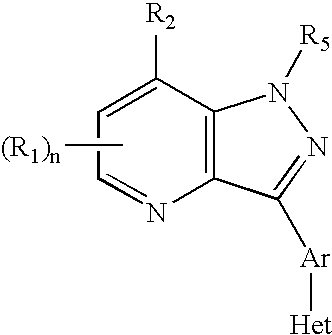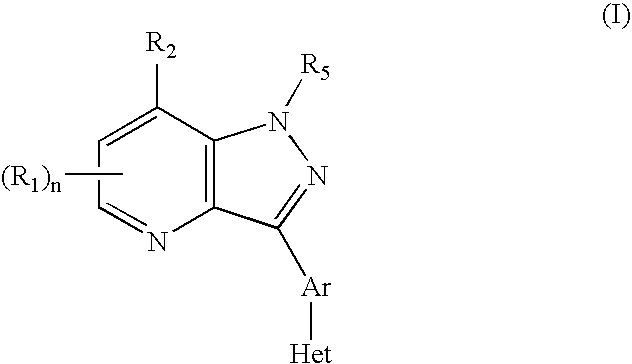CRF receptor antagonists and methods relating thereto
a technology of receptor antagonists and receptors, applied in the field of receptor antagonists, can solve the problems of lack of stability, limited oral activity, and suffer of peptide crf receptor antagonists
- Summary
- Abstract
- Description
- Claims
- Application Information
AI Technical Summary
Benefits of technology
Problems solved by technology
Method used
Image
Examples
example 1
SYNTHESIS OF REAGENTS 3-BROMO-7-CHLORO-5-METHYL-1H-PYRAZOLO[4,3-b]PYRIDINE AND 7-BENZYLOXY-3-BROMO-5-METHYL-1H-PYRAZOLO[4,3-b]PYRIDINE
[0133]
Step 1A:
[0134]Pyrazole (30.0 g, 441 mmol) was added portionwise to sulfuric acid (220 mL, 97%) in an ice-bath. The mixture was heated at 55° C. and nitric acid (30 mL, 70%, 0.5 mol) was added slowly. The reaction mixture was stirred at 55° C. for 3 hours, cooled down, poured into ice-water (600 mL) and neutralized with 6N NaOH solution (pH=7). The reaction mixture was extracted with ethyl acetate (5×150 mL). The organic phases were combined, washed with water (100 mL) and brine (100 mL), dried with sodium sulfate, filtered and concentrated by vacuum to afford compound 1a as a white solid (37.0 g, 326 mmol, 74%); GC / MS: m / z=113 (100%).
[0135]Compound 1a (15.0 g, 133 mmol) was added to a suspension of palladium on carbon 10% (7.0 g, 6.65 mmol) in ethanol (100 mL). The mixture was shaken for 3 hours under hydrogen pressure (40 psi) at room temperatu...
example 2
SYNTHESIS OF REAGENTS 1-(4-BROMO-3-METHYLPHENYL)PYRAZOLE AND 2-METHYL-4-(PYRAZOL-1-YL)PHENYLBORONIC ACID PINACOL ESTER
[0141]
Step 2A:
[0142]4-Bromo-3-methylaniline (10.2 g) was suspended in 6N HCl (85 mL) and cooled to 0° C. A solution of sodium nitrite (4 g in 40 mL H2O) was added over 10 min. The reaction was stirred for 15 min at 0° C. followed by the addition of stannous chloride dihydrate (36 g in 25 mL 12N HCl). The reaction was stirred for 2 hours at 0° C. The reaction was filtered, and the filter cake was washed with cold H2O to afford 4-bromo-3-methylphenylhydrazine hydrochloride (compound 2a, 20 g) as a tan solid.
Step 2B:
[0143]The compound resulting from Step 2A (20 g) was suspended in 50 mL ethanol. Malondialdehyde bis-dimethylacetal (11.0 mL, 67 mmol) was added and the reaction was heated to 85° C. for 2 hours. The reaction mixture was neutralized with sodium bicarbonate and extracted by washing with DCM. The combined organic layers were dried over magnesium sulfate and co...
example 3
SYNTHESIS OF REAGENTS 7-BENZYLOXY-1,5-DIMETHYL-3-(2-METHYL-4-PYRAZOL-1-YL-PHENYL)-1H-PYRAZOLO[4,3-b]PYRIDINE AND 1,5-DIMETHYL-3-(2-METHYL-4-PYRAZOL-1-YL-PHENYL)-1H-PYRAZOLO[4,3-b]PYRIDIN-7-OL
[0147]
Step 3A:
[0148]To a solution of compound 1g (1.0 g in 5 mL toluene) was added ethanol (2 mL). To this mixture was added compound 2d (1.3 g) followed by aqueous sodium carbonate (3.5 mL of 2.0 M solution), saturated aqueous barium hydroxide (1 mL) and tetrakis(triphenylphosphine)palladium(0) (200 mg, 0.15 mmol). The reaction mixture was stirred and heated at 85° C. for 12 hours. The mixture was cooled and the organic phase was separated. The aqueous phase was washed with ethyl acetate (3×50 mL), and the combined organic extracts were dried over magnesium sulfate, filtered, and concentrated to a yellow oil which was purified by column chromatography (30% ethyl acetate:hexanes) to afford 7-benzyloxy-1,5-dimethyl-3-(2-methyl-4-pyrazol-1-yl-phenyl)-1H-pyrazolo[4,3-b]pyridine (compound 3a, 0.82 ...
PUM
| Property | Measurement | Unit |
|---|---|---|
| temperature | aaaaa | aaaaa |
| pH | aaaaa | aaaaa |
| initial temperature | aaaaa | aaaaa |
Abstract
Description
Claims
Application Information
 Login to View More
Login to View More - R&D
- Intellectual Property
- Life Sciences
- Materials
- Tech Scout
- Unparalleled Data Quality
- Higher Quality Content
- 60% Fewer Hallucinations
Browse by: Latest US Patents, China's latest patents, Technical Efficacy Thesaurus, Application Domain, Technology Topic, Popular Technical Reports.
© 2025 PatSnap. All rights reserved.Legal|Privacy policy|Modern Slavery Act Transparency Statement|Sitemap|About US| Contact US: help@patsnap.com



